Application of Particle Swarm Optimization to a Scheduling Strategy for Microgrids Coupled with Natural Gas Networks
Abstract
1. Introduction
2. Modeling of Integrated Energy System
2.1. Micro Grid’s (Electricity Network) Component Modeling
2.1.1. Photovoltaic
2.1.2. Wind Turbine
2.1.3. Fuel Cell
2.1.4. Micro Turbine
2.1.5. Batteries
2.1.6. Main Grid
2.2. Natural Gas Network Modeling
2.2.1. Pipeline Model
2.2.2. Compressor Model
2.3. Micro Grid and Natural Gas Coupling Constraints
3. Coupled Networks’ Dispatch Strategy
4. Case Study
5. Conclusions
- We formulated the power dispatch strategy of a microgrid coupled with a natural gas network as a multi-objective problem and used PSO to solve it.
- Limited the search area for PSO.
- Included pollution treatment costs or emission penalties.
- Verified the effectiveness of the proposed strategy. First, a test was done to check its convergence speed and find out a sufficient number of iterations and then it was applied to the proposed Integrated Energy System (IES).
- The results provided an optimal dispatch scheme, which is able to reduce the operational cost of the microgrid by 0. 6710 million RMB per day.
- The proposed strategy not only provides an optimal dispatch, but also reduces the power dependability of the microgrid in such a way that it helps the main grid to smoothen its power demand curve.
Author Contributions
Funding
Conflicts of Interest
Nomenclature
| A | Area of PV panels |
| Total social cost of FC at time t | |
| Total social cost of battery at time t | |
| Total social cost of MT at time t | |
| Total social cost of PV at time t | |
| Total social cost of a wind turbine at time t | |
| Natural gas price per unit | |
| Pollution treatment cost for MT | |
| Fuel cost for MT | |
| MT maintenance cost | |
| Power curve provided by WT manufacture | |
| Global tilted solar irradiation on PV | |
| Fuel cell stack current | |
| Maintenance cost constant for MT | |
| Number of units installed | |
| Power supplied or stored (charge or discharge) by battery at time t | |
| Estimated power generated by FC at time t | |
| Power generated by MT at time t | |
| Estimated power generated by PV at time t | |
| Estimated power generated by WT at time t | |
| Index of hour | |
| All hours in the year | |
| DC voltage between stack of FC at time t | |
| Velocity of the wind at time t | |
| Maintenance coefficient for battery | |
| Maintenance coefficient for FC | |
| Emission characteristic coefficient for MT | |
| Maintenance coefficient of PV | |
| Maintenance coefficient of wind turbine | |
| Emission characteristic coefficient for battery | |
| FC value depreciation coefficient | |
| Value depreciation coefficient for MT | |
| PV value depreciation coefficient | |
| Wind value depreciation coefficient | |
| Pollution treatment cost coefficient for battery | |
| Pollution treatment cost coefficient for FC | |
| Emission characteristic coefficient for MT | |
| Pollution treatment cost coefficient for PV | |
| Pollution treatment cost coefficient for wind turbine | |
| Efficiency of solar PV | |
| MT Power generation efficiency at time t | |
| Emission characteristic coefficient for MT | |
| Unit pollution cost | |
| Emission characteristic coefficient for MT |
References
- Gu, W.; Wang, Z.; Wu, Z.; Luo, Z.; Tang, Y.; Wang, J. An Online Optimal Dispatch Schedule for CCHP Microgrids Based on Model Predictive Control. IEEE Trans. Smart Grid 2017, 8, 2332–2342. [Google Scholar] [CrossRef]
- Wu, J.; Yan, J.; Jia, H.; Hatziargyriou, N.; Djilali, N.; Sun, H. Integrated energy systems. Appl. Energy 2016, 167, 155–157. [Google Scholar] [CrossRef]
- Qian, A.; Ran, H. Key technologies and challenges for multi-energy complementarity and optimization of integrated energy system. Autom. Electr. Power Syst. 2018, 42, 2–10. [Google Scholar]
- Olivares, D.E.; Mehrizi-Sani, A.; Etemadi, A.H.; Cañizares, C.A.; Iravani, R.; Kazerani, M.; Hajimiragha, A.H.; Gomis-Bellmunt, O.; Saeedifard, M.; Palma-Behnke, R.; et al. Trends in microgrid control. IEEE Trans. Smart Grid 2014, 5, 1905–1919. [Google Scholar] [CrossRef]
- Li, Q.; An, S.; Gedra, T. Solving natural gas loadflow problems using electric loadflow techniques. In Proceedings of the North American Power Symposium, Rolla, MO, USA, 20–21 October 2003. [Google Scholar]
- Seungwon, A.; Qing, L.; Gedra, T.W. Natural gas and electricity optimal power flow. In Proceedings of the 2003 IEEE PES Transmission and Distribution Conference and Exposition, Dallas, TX, USA, 7–12 September 2003; Volume 1, pp. 138–143. [Google Scholar] [CrossRef]
- Qiu, J.; Zhao, J.; Yang, H.; Dong, Z.Y. Optimal Scheduling for Prosumers in Coupled Transactive Power and Gas Systems. IEEE Trans. Power Syst. 2018, 33, 1970–1980. [Google Scholar] [CrossRef]
- Unsihuay, C.; Lima, J.W.M.; de Souza, A.C.Z. Modeling the Integrated Natural Gas and Electricity Optimal Power Flow. In Proceedings of the 2007 IEEE Power Engineering Society General Meeting, Tampa, FL, USA, 24–28 June 2007; pp. 1–7. [Google Scholar] [CrossRef]
- Martinez-Mares, A.; Fuerte-Esquivel, C.R. A unified gas and power flow analysis in natural gas and electricity coupled networks. IEEE Trans. Power Syst. 2012, 27, 2156–2166. [Google Scholar] [CrossRef]
- Wu, L.L.; Wu, Q.H.; Jing, Z.X.; Wei, F.; Deng, S.; Zhou, X.X. Optimal power and gas dispatch of the integrated electricity and natural gas networks. In Proceedings of the IEEE PES Innovative Smart Grid Technologies Conference Europe, Melbourne, Australia, 28 November–1 December 2016; pp. 244–249. [Google Scholar]
- Kou, Y.N.; Zheng, J.H.; Li, Z.; Wu, Q.H. Many-objective optimization for coordinated operation of integrated electricity and gas network. J. Mod. Power Syst. Clean Energy 2017, 5, 350–363. [Google Scholar] [CrossRef]
- Shabanpour-Haghighi, A.; Seifi, A.R. An integrated steady-state operation assessment of electrical, natural gas, and district heating networks. IEEE Trans. Power Syst. 2016, 31, 3636–3647. [Google Scholar] [CrossRef]
- Colson, C.M.; Nehrir, M.H.; Wang, C. Ant colony optimization for microgrid multi-objective power management. In Proceedings of the 2009 IEEE/PES Power Systems Conference and Exposition, Seattle, WA, USA, 15–18 March 2009. [Google Scholar]
- Conti, S.; Nicolosi, R.; Rizzo, S.A. Optimal dispatching of distributed generators in an MV autonomous micro-grid to minimize operating costs and emissions. In Proceedings of the IEEE International Symposium on Industrial Electronics, Bari, Italy, 4–7 July 2010; pp. 2542–2547. [Google Scholar]
- Hatziargyriou, N.; Contaxis, G.; Matos, M.; Pecas Lopes, J.A.; Kariniotakis, G.; Mayer, D.; Halliday, J.; Dutton, G.; Dokopoulos, P.; Bakirtzis, A.; et al. Energy management and control of island power systems with increased penetration from renewable sources. In Proceedings of the 2002 IEEE Power Engineering Society Winter Meeting, New York, NY, USA, 27–31 January 2002; Volume 1, pp. 335–339. [Google Scholar] [CrossRef]
- Baskar, S.; Subbaraj, P.; Rao, M.V.C. Hybrid real coded genetic algorithm solution to economic dispatch problem. Comput. Electr. Eng. 2003, 29, 407–419. [Google Scholar] [CrossRef]
- Alvarez, E.; Lopez, A.C.; Gómez-Aleixandre, J.; De Abajo, N. On-line minimization of running costs, greenhouse gas emissions and the impact of distributed generation using microgrids on the electrical system. In Proceedings of the 1st IEEE-PES/IAS Conference on Sustainable Alternative Energy, Valencia, Spain, 28–30 September 2009. [Google Scholar]
- Kanchev, H.; Lu, D.; Colas, F.; Lazarov, V.; Francois, B. Energy management and operational planning of a microgrid with a PV-based active generator for smart grid applications. IEEE Trans. Ind. Electron. 2011, 58, 4583–4592. [Google Scholar] [CrossRef]
- Kanchev, H.; Lu, D.; Francois, B.; Lazarov, V. Smart monitoring of a microgrid including gas turbines and a dispatched PV-based active generator for energy management and emissions reduction. In Proceedings of the IEEE PES Innovative Smart Grid Technologies Conference Europe, Gothenberg, Sweden, 11–13 October 2010. [Google Scholar]
- Mahdi, F.P.; Vasant, P.; Rahman, M.M.; Abdullah-Al-Wadud, M.; Watada, J.; Kallimani, V. Quantum particle swarm optimization for multiobjective combined economic emission dispatch problem using cubic criterion function. In Proceedings of the 2017 IEEE International Conference on Imaging, Vision and Pattern Recognition, Dhaka, Bangladesh, 13–14 February 2017. [Google Scholar]
- Colson, C.M.; Nehrir, M.H.; Pourmousavi, S.A. Towards real-time microgrid power management using computational intelligence methods. In Proceedings of the IEEE PES General Meeting, Providence, RI, USA, 25–29 July 2010. [Google Scholar]
- Twaha, S.; Ramli, M.A.M. A review of optimization approaches for hybrid distributed energy generation systems: Off-grid and grid-connected systems. Sustain. Cities Soc. 2018, 41, 320–331. [Google Scholar] [CrossRef]
- Singh, H.; Srivastava, L. Hybrid multi-swarm particle swarm optimisation based multi-objective reactive power dispatch. IET Gener. Transm. Distrib. 2015, 9, 727–739. [Google Scholar] [CrossRef]
- Shareef, S.M.; Srinivasa Rao, R. Optimal reactive power dispatch under unbalanced conditions using hybrid swarm intelligence. Comput. Electr. Eng. 2018, 69, 183–193. [Google Scholar] [CrossRef]
- Wang, F.; Zhou, L.; Ren, H.; Liu, X. Search improvement process-chaotic optimization-particle swarm optimization-elite retention strategy and improved combined cooling-heating-power strategy based two-Time scale multi-objective optimization model for stand-Alone microgrid operation. Energies 2017, 10. [Google Scholar] [CrossRef]
- Khaled, U.; Eltamaly, A.M.; Beroual, A. Optimal power flow using particle swarm optimization of renewable hybrid distributed generation. Energies 2017, 10, 1013. [Google Scholar] [CrossRef]
- Huang, W.T.; Chen, T.H.; Chen, H.T.; Yang, J.S.; Lian, K.L.; Chang, Y.R.; Lee, Y.D.; Ho, Y.H. A two-stage optimal network reconfiguration approach for minimizing energy loss of distribution networks using particle swarm optimization algorithm. Energies 2015, 8, 13894–13910. [Google Scholar] [CrossRef]
- Liu, Z.; Chen, C.; Yuan, J. Hybrid Energy Scheduling in a Renewable Micro Grid. Appl. Sci. 2015, 5, 516–531. [Google Scholar] [CrossRef]
- Osiadacz, A. Integration of Large-Scale Renewable Energy into Bulk Power Systems; Springer: Berlin, Germany, 2017. [Google Scholar] [CrossRef]
- Kennedy, J. Particle swarm optimization. Briefs Appl. Sci. Technol. 2016, 182, 1942–1948. [Google Scholar] [CrossRef]
- Shi, Y.; Eberhart, R. A modified particle swarm optimizer. In Proceedings of the 1998 IEEE International Conference on Evolutionary Computation Proceedings. IEEE World Congress on Computational Intelligence (Cat. No.98TH8360), Anchorage, AK, USA, 4–9 May 1998; pp. 69–73. [Google Scholar] [CrossRef]
- Jiang, Y.; Xu, J.; Sun, Y.; Wei, C.; Wang, J.; Liao, S.; Ke, D.; Li, X.; Yang, J.; Peng, X. Coordinated operation of gas-electricity integrated distribution system with multi-CCHP and distributed renewable energy sources. Appl. Energy 2018, 211, 237–248. [Google Scholar] [CrossRef]
- Kefayat, M.; Lashkar Ara, A.; Nabavi Niaki, S.A. A hybrid of ant colony optimization and artificial bee colony algorithm for probabilistic optimal placement and sizing of distributed energy resources. Energy Convers. Manag. 2015, 92, 149–161. [Google Scholar] [CrossRef]
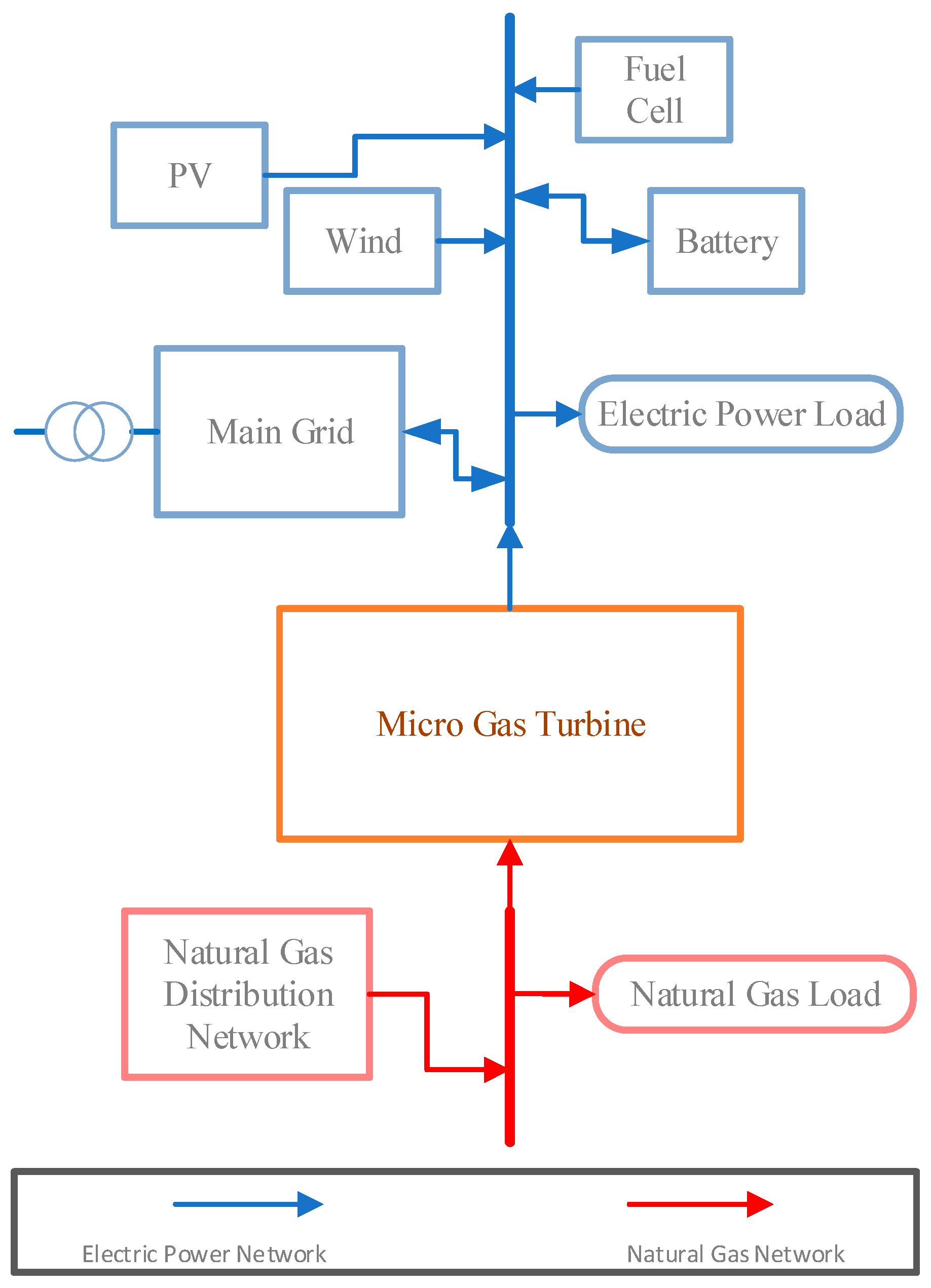
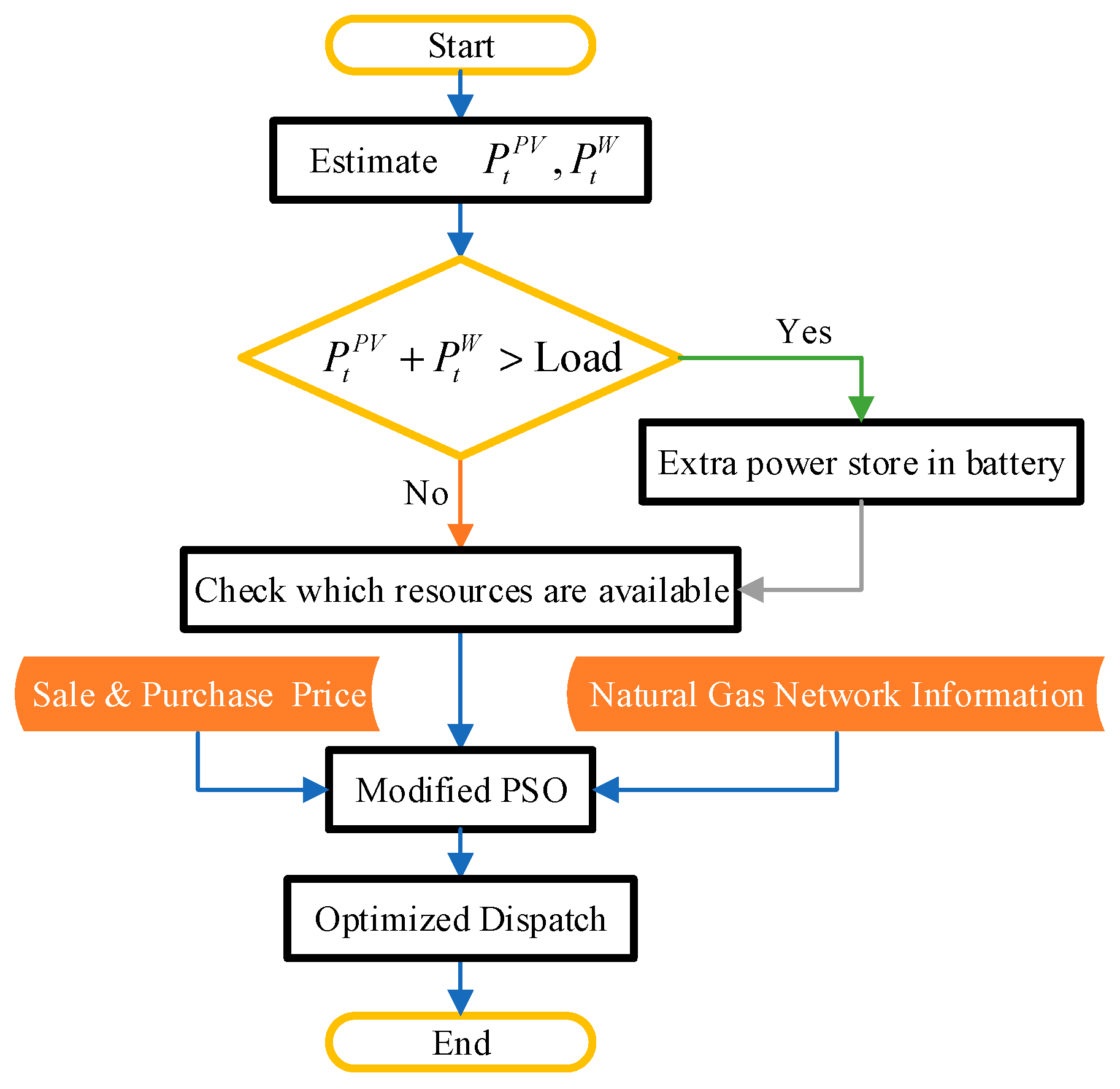
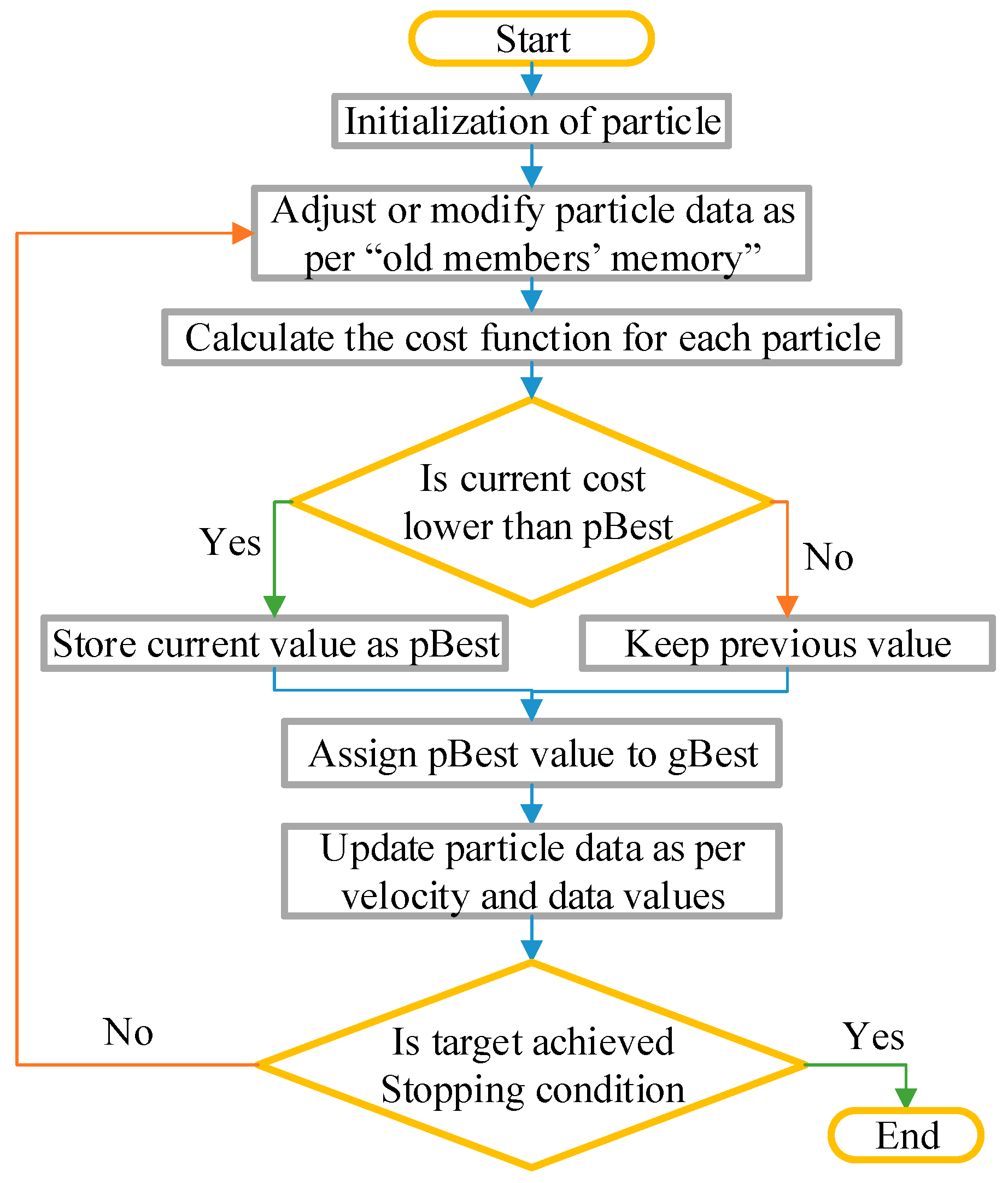




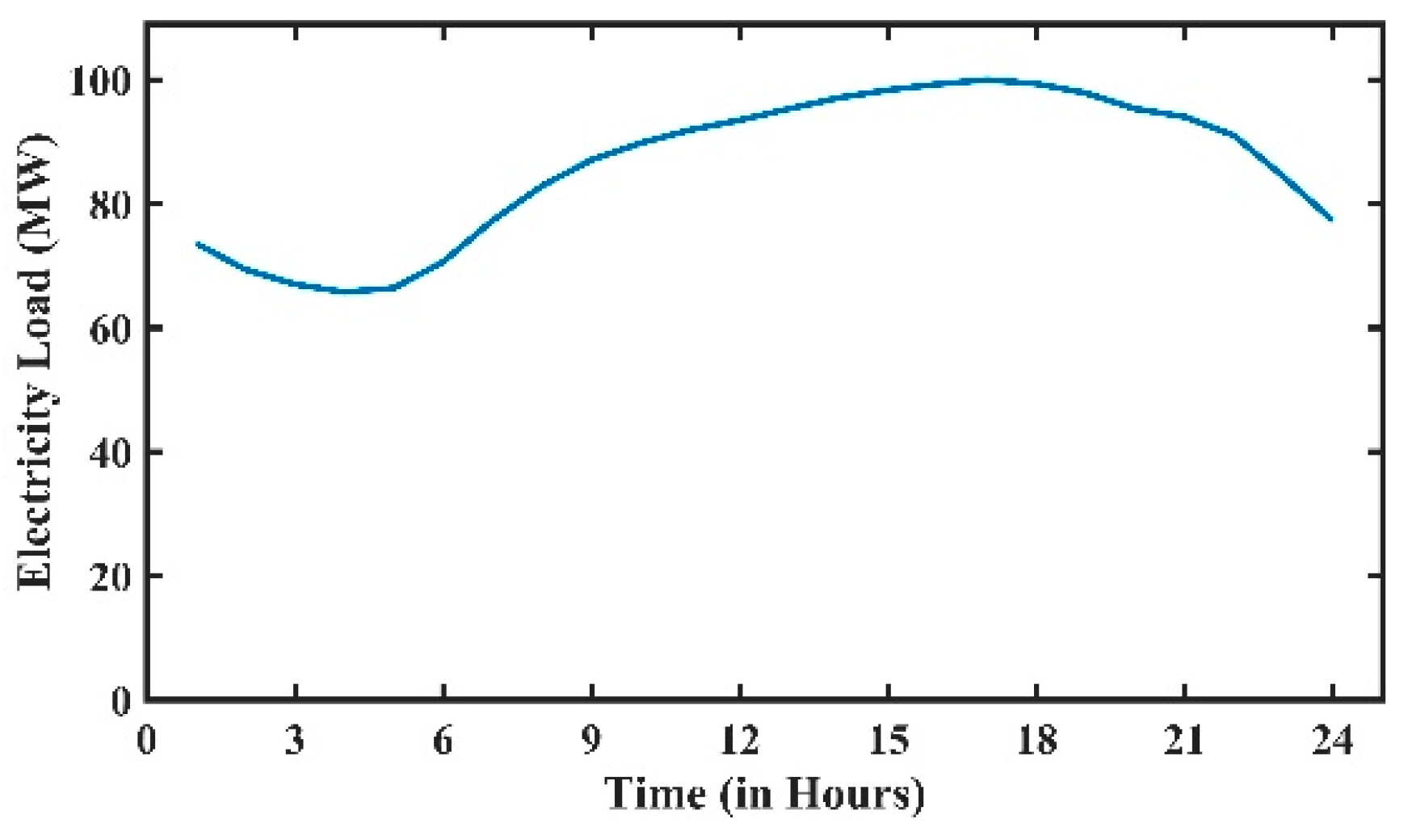

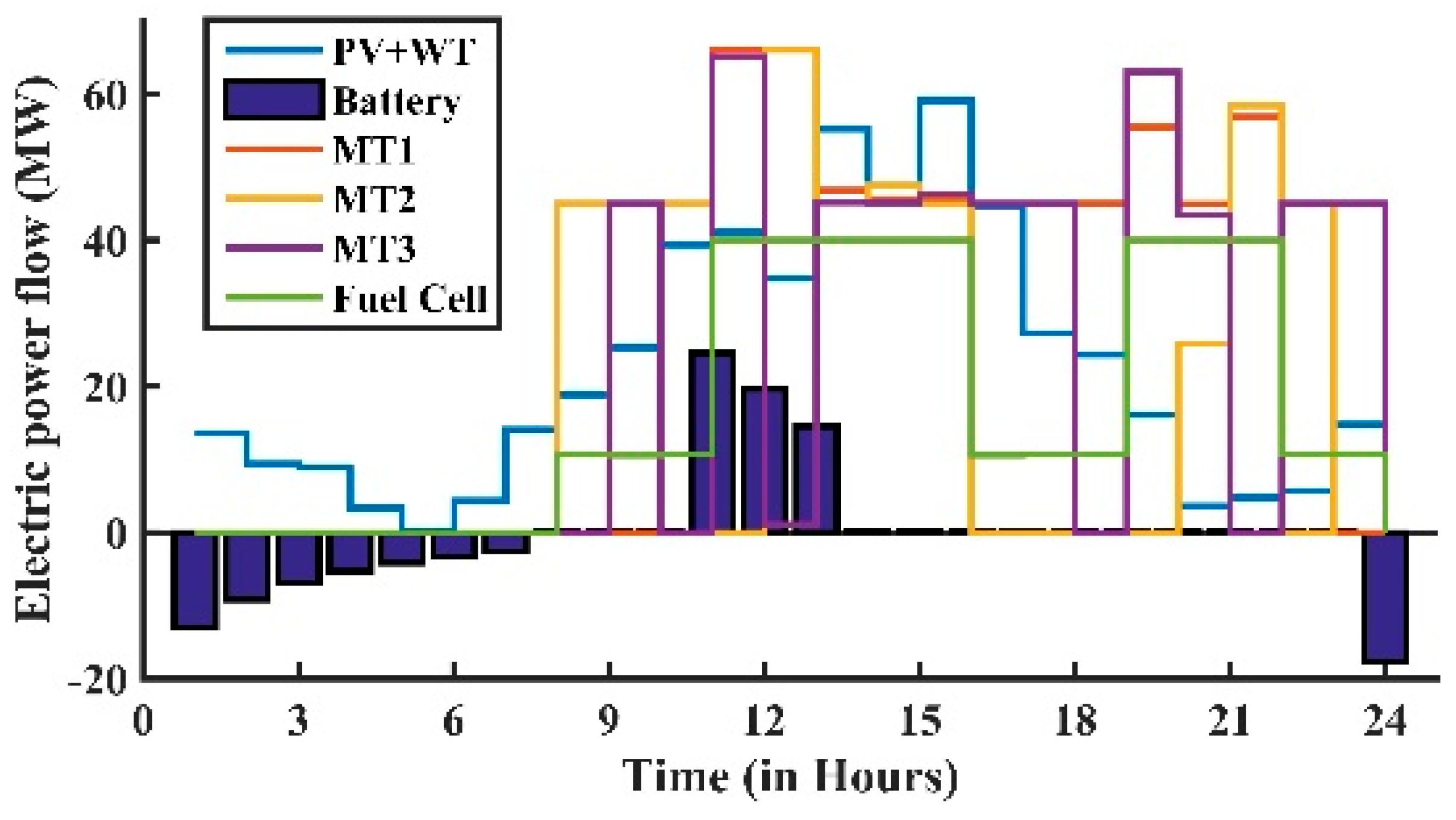
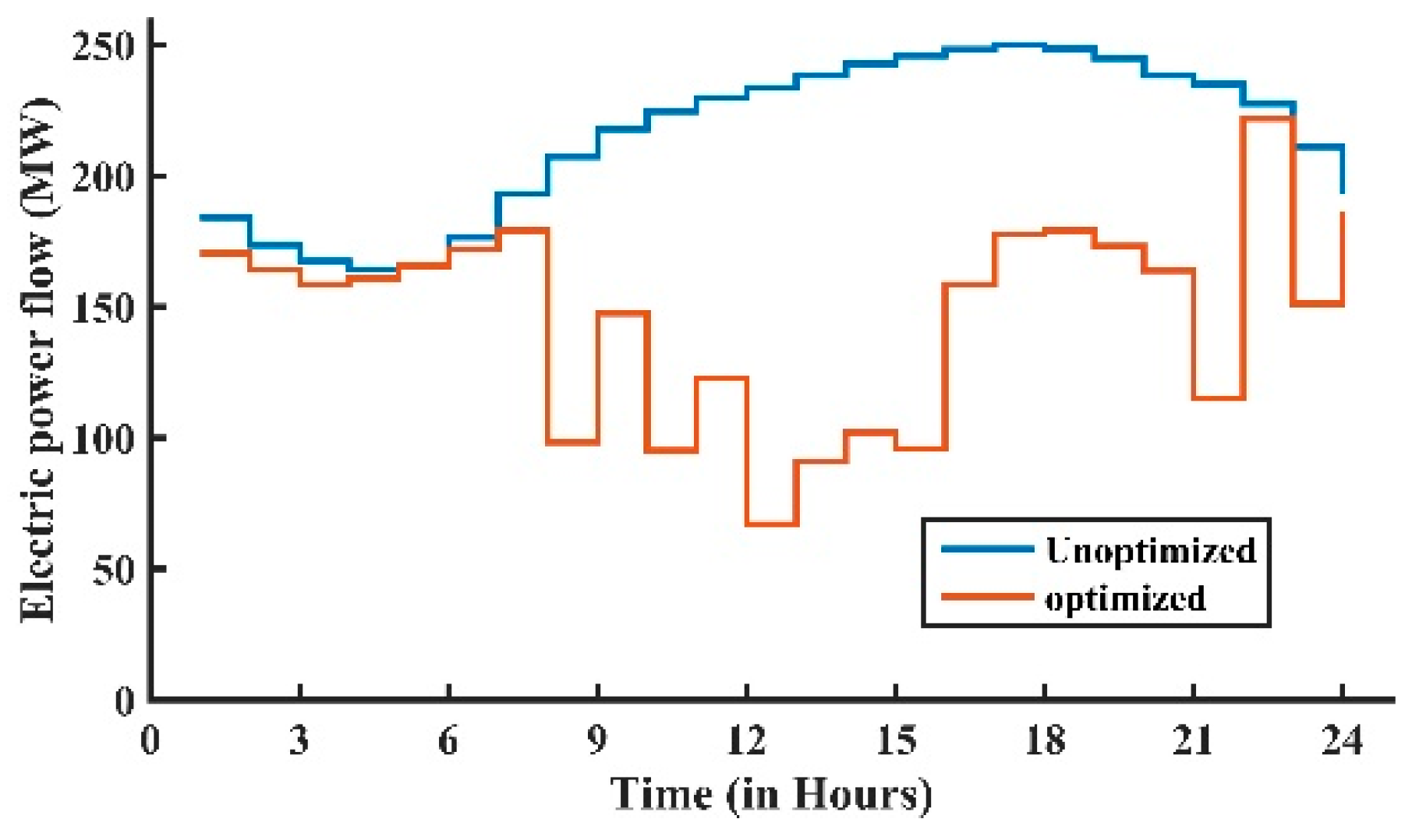
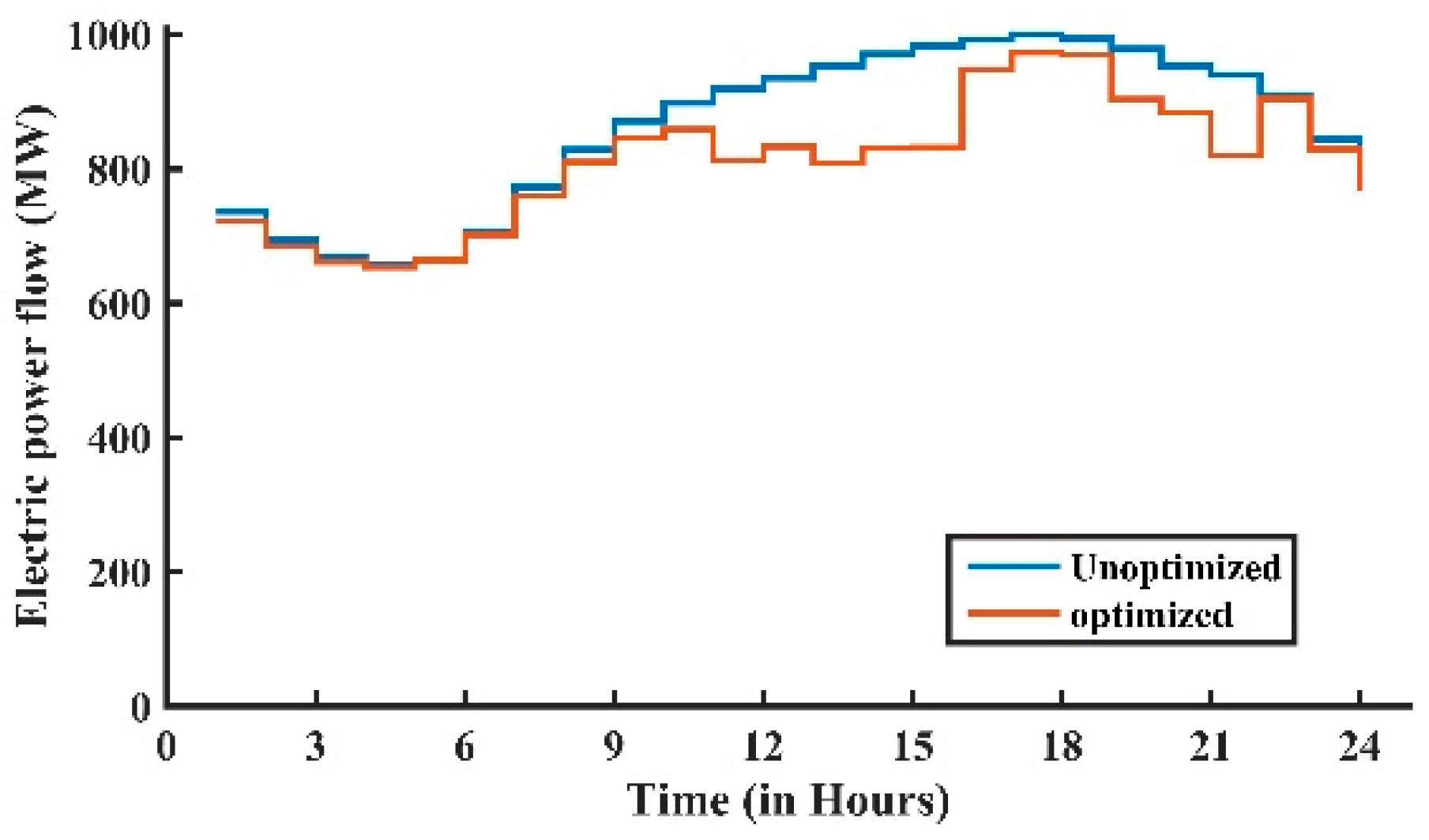
| Source | Description |
|---|---|
| Micro Turbine | 3 × 66 MW/h |
| Fuel cell | 40 MW/h |
| Wind Turbine | 50 MW/h |
| PV | 100 MW/h |
| Grid (±max) | 250 MW/h |
| Load (max) | 250 MW/h |
| Battery bank | 80 MWh |
| Source | Description |
|---|---|
| Gas source 1 | 13,800 m3/h |
| Gas source 2 | 10,200 m3/h |
| Gas load (max) | 6000 m3/h |
| Gas MT demand (max) | 31,200 m3/h |
| Technique (24 h) a | Cost (million RMB) | Time (s) |
|---|---|---|
| Main Grid | 2.7240 | 0.00 c |
| LR b | 2.0533 | 9.84 |
| Ant Colony Optimization (ACO) d | 2.0433 | 3.58 |
| Artificial Bee Colony algorithm (ABC) d | 2.0529 | 7.12 |
| PSO d | 2.0529 | 5.42 |
| Proposed PSO d | 2.0529 | 4.52 |
| Unit | Hours (1–24) |
|---|---|
| 1 | 0 0 0 0 0 0 0 1 0 1 1 1 1 1 1 1 0 1 1 1 0 0 1 0 |
| 2 | 0 0 0 0 0 0 0 0 1 0 1 1 1 1 1 0 1 0 1 0 1 1 0 0 |
| 3 | 0 0 0 0 0 0 0 1 1 0 0 1 1 1 1 1 0 1 0 1 1 0 1 0 |
© 2018 by the authors. Licensee MDPI, Basel, Switzerland. This article is an open access article distributed under the terms and conditions of the Creative Commons Attribution (CC BY) license (http://creativecommons.org/licenses/by/4.0/).
Share and Cite
Yousif, M.; Ai, Q.; Gao, Y.; Wattoo, W.A.; Jiang, Z.; Hao, R. Application of Particle Swarm Optimization to a Scheduling Strategy for Microgrids Coupled with Natural Gas Networks. Energies 2018, 11, 3499. https://doi.org/10.3390/en11123499
Yousif M, Ai Q, Gao Y, Wattoo WA, Jiang Z, Hao R. Application of Particle Swarm Optimization to a Scheduling Strategy for Microgrids Coupled with Natural Gas Networks. Energies. 2018; 11(12):3499. https://doi.org/10.3390/en11123499
Chicago/Turabian StyleYousif, Muhammad, Qian Ai, Yang Gao, Waqas Ahmad Wattoo, Ziqing Jiang, and Ran Hao. 2018. "Application of Particle Swarm Optimization to a Scheduling Strategy for Microgrids Coupled with Natural Gas Networks" Energies 11, no. 12: 3499. https://doi.org/10.3390/en11123499
APA StyleYousif, M., Ai, Q., Gao, Y., Wattoo, W. A., Jiang, Z., & Hao, R. (2018). Application of Particle Swarm Optimization to a Scheduling Strategy for Microgrids Coupled with Natural Gas Networks. Energies, 11(12), 3499. https://doi.org/10.3390/en11123499







